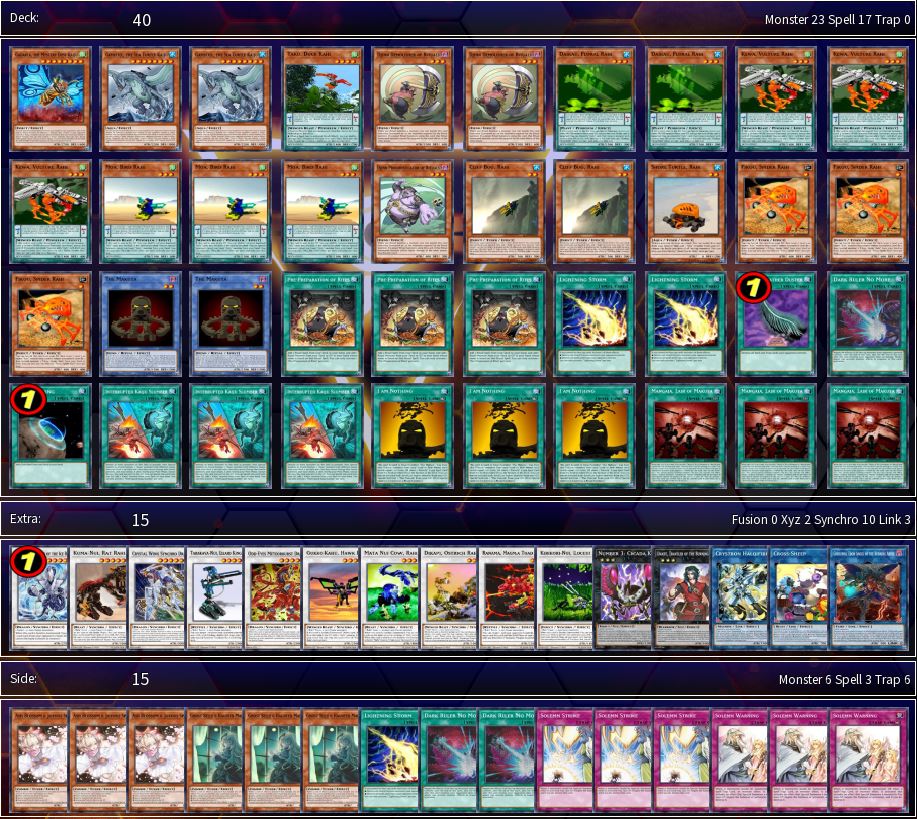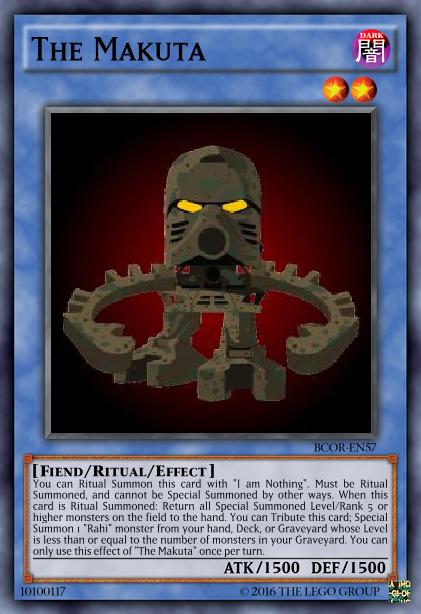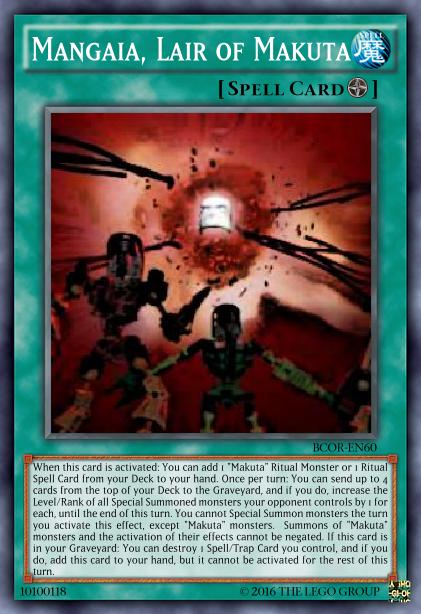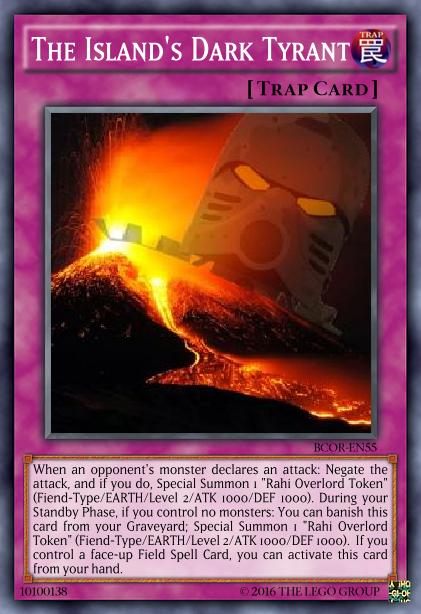In a bit of a break from the usual Type-specific substrategies, we also have an approach to Rahi decks that revolves around one boss monster in particular, and the general DARK Attribute by extension. Meet the Rahi Nui – or what is left of it by the time the Toa Nuva come across it, anyway.
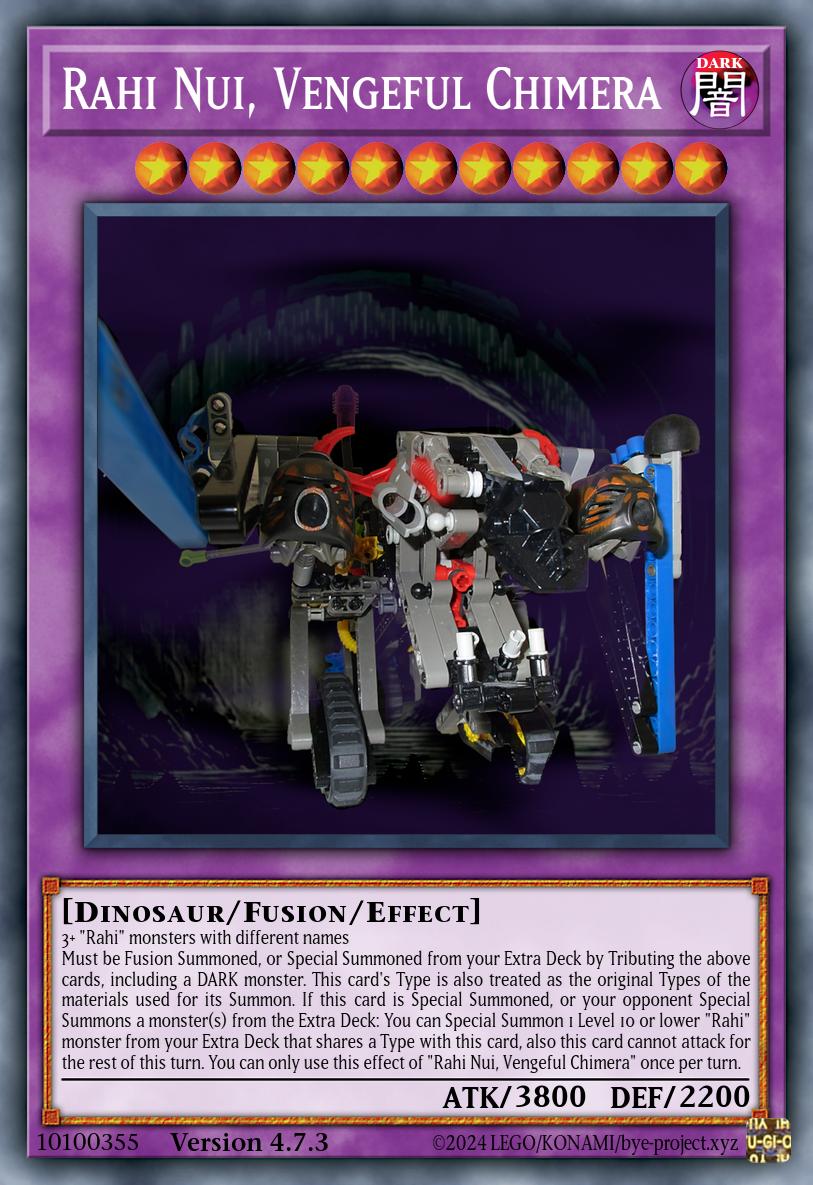
Rahi Nui, Vengeful Chimera
Fusion Effect MonsterLevel 11 | DARK Dinosaur | ATK 3800 / DEF 22003+ “Rahi” monsters with different names
Must be Fusion Summoned, or Special Summoned from your Extra Deck by Tributing the above cards, including a DARK monster. This card’s Type is also treated as the original Types of the materials used for its Summon. If this card is Special Summoned, or your opponent Special Summons a monster(s) from the Extra Deck: You can Special Summon 1 Level 10 or lower “Rahi” monster from your Extra Deck that shares a Type with this card, also this card cannot attack for the rest of this turn. You can only use this effect of “Rahi Nui, Vengeful Chimera” once per turn.
Reassembled after once disintegrating through the treachery of one particularly resourceful group of Toa, this amalgamation of Tarakava , Muaka , Kane-Ra , Nui-Rama , and Nui-Jaga wields its might in pursuit of revenge, lurking in the darkness. That about sums up the design concept here, so let’s unpack that in some more detail.
Being a big (hypothetical) combiner means it’s a big Fusion, though the minimum materials are just a more manageable number of 3 different Rahi rather than the 5 canon ones. Since said canon materials span a variety of Types, the Rahi Nui absorbs those Types into itself, much like it clearly shows traits of them all (yes, big punchy fists are a Reptile trait, never seen a crocodile?). Also, because DARK Rahi are kind of rare throughout the whole lore, it has a Contact Fusion clause if you can get those involved.
Once it hits the field, the multiple Types become relevant, because they now let you cheat out (or in the case of Pendulums, simply bring back) other matching Rahi from the Extra Deck. The vibe here is meant to be like fighting a boss that throws other bosses from earlier in the game at you, which doesn’t have a real reason I’m aware of, but just felt right. In any case, it also does that whenever your opponent Special Summons from the Extra Deck, and that’s where the “revenge” aspect comes in.
You see, the Toa Metru that once felled the beast are, at this point in time, living happily in the Extra Deck as Turaga . So when they appear, the Rahi Nui gets “triggered”, flies into a rage, and ends up stuck in a wall so it can’t attack. Just like that one time with Vakama.
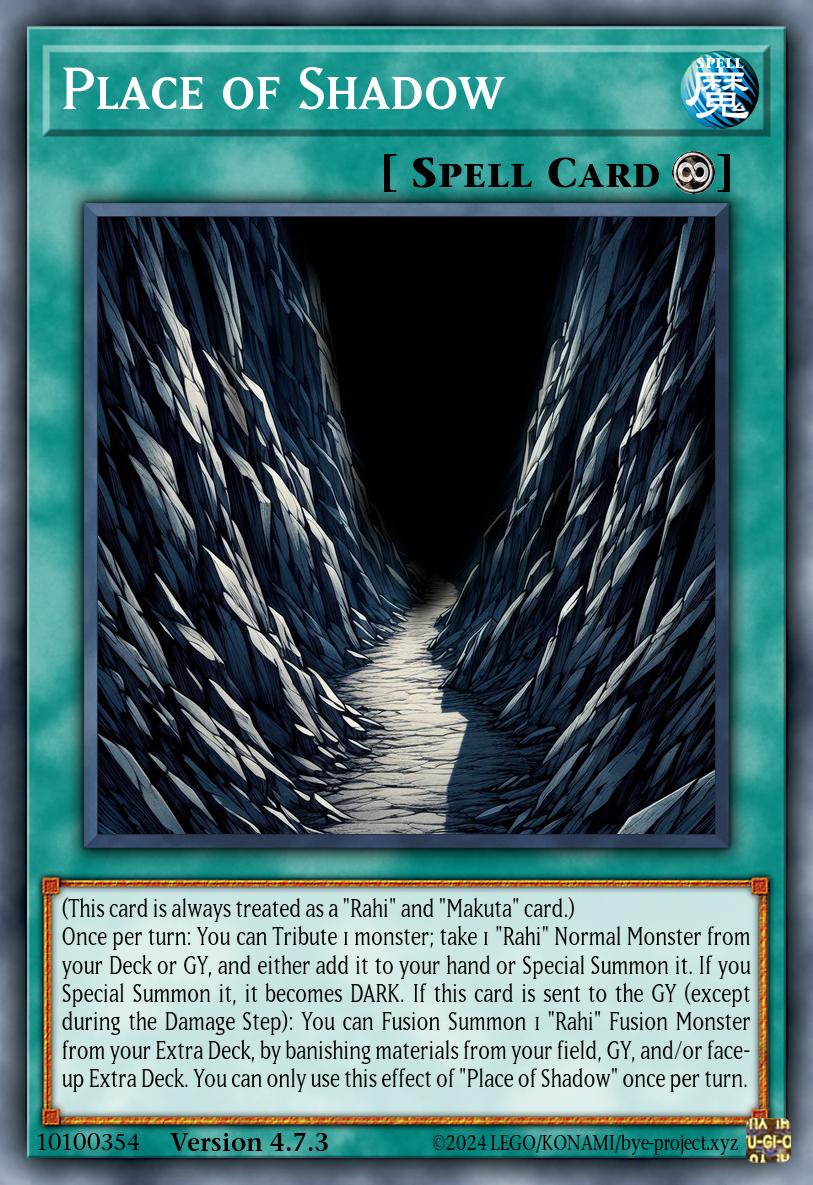
Place of Shadow
Continuous Spell(This card is always treated as a “Rahi” and “Makuta” card.)
Once per turn: You can Tribute 1 monster; take 1 “Rahi” Normal Monster from your Deck or GY, and either add it to your hand or Special Summon it. If you Special Summon it, it becomes DARK. If this card is sent to the GY (except during the Damage Step): You can Fusion Summon 1 “Rahi” Fusion Monster from your Extra Deck, by banishing materials from your field, GY, and/or face-up Extra Deck. You can only use this effect of “Place of Shadow” once per turn.
The location of that incident was the area known as the Place of Shadow, a section of Mata Nui completely under Makuta’s dark influence where the Rahi Nui made its lair. Speaking of which, this name sure sounds like Lair of Darkness, which is why we have an effect that Tributes a monster to bring out a Rahi and make it DARK – both synergyzing with and mimicking that pre-existing Field Spell. And the fact that it gets only Rahi Normal Monsters, which are of course precisely those species that make up the Rahi Nui, creates a bridge between those intended materials and the DARK Contact Fusion clause. Finally, like on most Rahi (and Makuta) Spell/Trap Cards, there’s a GY effect, in this case also to Fusion Summon … exactly the Rahi Nui, because we don’t have other Rahi Fusions. Yet.
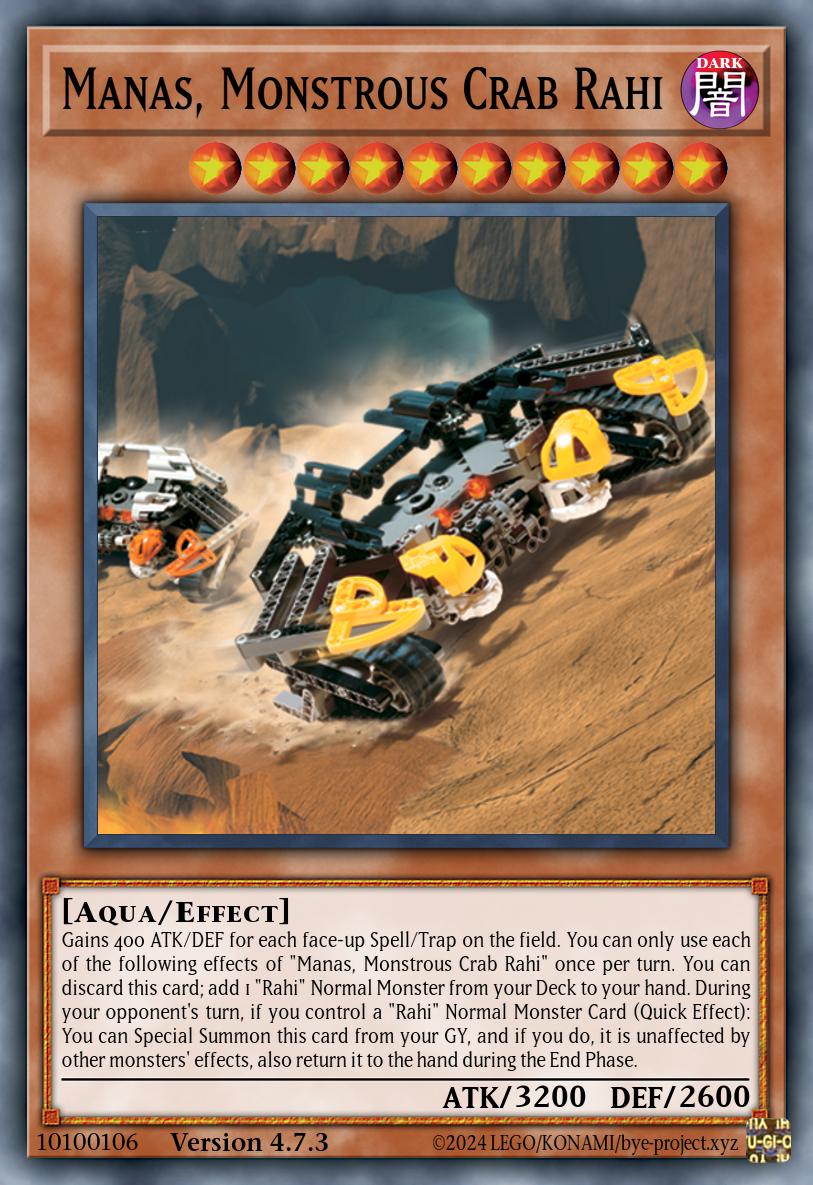
Manas, Monstrous Crab Rahi
Effect MonsterLevel 10 | DARK Aqua | ATK 3200 / DEF 2600Gains 400 ATK/DEF for each face-up Spell/Trap on the field. You can only use each of the following effects of “Manas, Monstrous Crab Rahi” once per turn. You can discard this card; add 1 “Rahi” Normal Monster from your Deck to your hand. During your opponent’s turn, if you control a “Rahi” Normal Monster Card (Quick Effect): You can Special Summon this card from your GY, and if you do, it is unaffected by other monsters’ effects, also return it to the hand during the End Phase.
As a side note, there actually was already a DARK-themed support card for the Normal Monsters in the very first wave of Rahi: The Manas, which simply searches them out from the hand and then uses their presence to haul its giant ass onto the field during the opponent’s turn. Nothing too amazing, but a consistency card that can also be a big beatstick or at least a shield if push comes to shove sure is nice to have if we’re already focusing on the right Attribute.
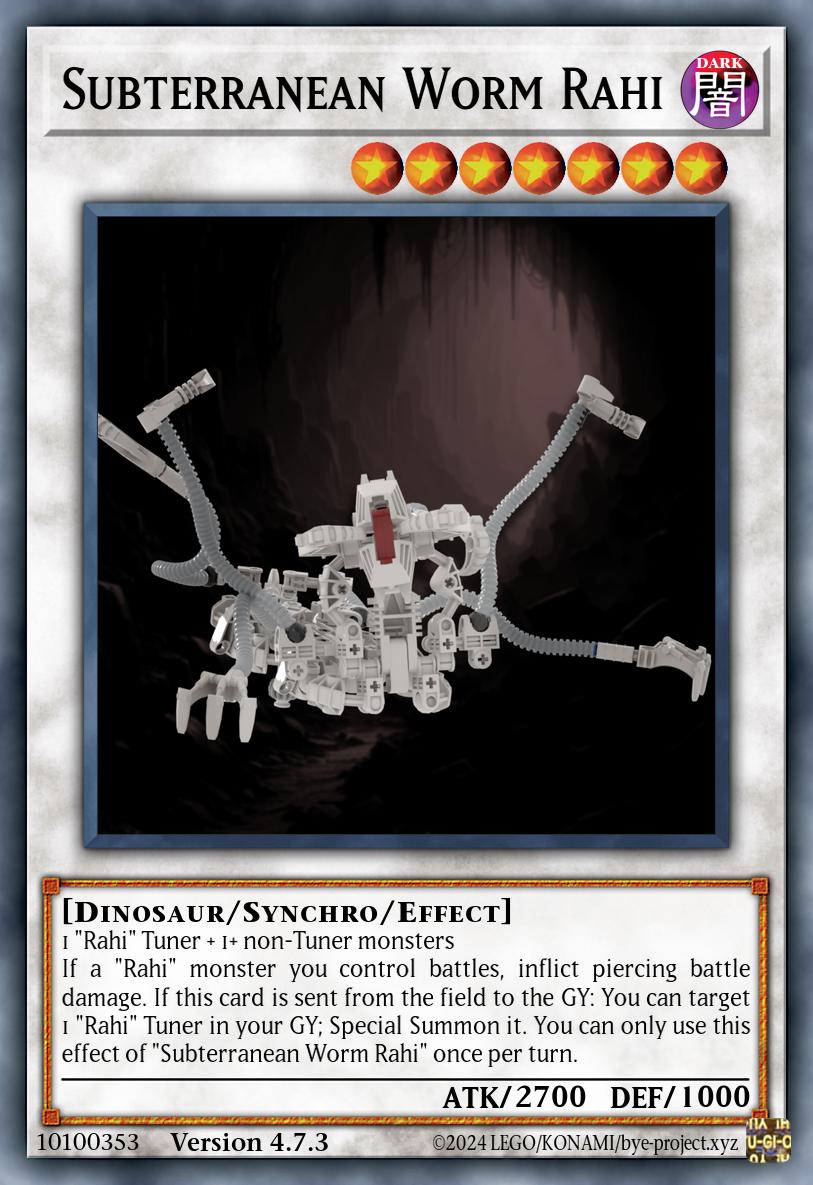
Subterranean Worm Rahi
Synchro Effect MonsterLevel 7 | DARK Dinosaur | ATK 2700 / DEF 10001 “Rahi” Tuner + 1+ non-Tuner monsters
If a “Rahi” monster you control battles, inflict piercing battle damage. If this card is sent from the field to the GY: You can target 1 “Rahi” Tuner in your GY; Special Summon it. You can only use this effect of “Subterranean Worm Rahi” once per turn.
In addition to the two summoning methods available in the Place of Shadow, there is also one that’s even more splashable by virtue of not requiring any special Main Deck accomodations. Just put a Subterranean Worm in your Extra Deck, find a Level 7 Synchro line that also leaves two additional Rahi out, and there’s your Rahi Nui. Also the Contact Fusion sent the Worm to the GY, so you get back a Tuner to do some Synchro climbing with whatever you’re cheating out.
You do need to put in some work, but having this as an option that’s always accessible is convenient. So convenient that it comes with a slight drawback of both the (supposedly ancient) Worm and the (big and scary) Rahi Nui sharing the Dinosaur Type, meaning you only get to meaningfully inherit Types from the other two materials. Still an excellent choice for something like a Beast deck that easily spams monsters and only needs to access its native Types anyway. Plus, you can always use your Dinosaur-Type Rahi Nui to bring out another Dinosaur-Type Subterranean Worm, in case you need piercing damage.

MKT Fish, Biting Rahi
Tuner Effect MonsterLevel 3 | DARK Fish | ATK 900 / DEF 300If this card you control would be used as Synchro Material, you can treat it as a non-Tuner. During your opponent’s Main Phase, you can (Quick Effect): Immediately after this effect resolves, Synchro Summon using Fish, Sea Serpent, and/or Aqua monsters you control, including this card. You can only use this effect of “MKT Fish, Biting Rahi” once per turn.
Finally, a DARK Rahi with only tangential relation to this theme: The MaKuTa Fish. You can technically use one of these as Rahi Nui material, but it’s not particularly easy to get on the field, doesn’t provide any benefit to your general strategy, and most importantly there isn’t a single Fish Rahi Synchro in the Extra Deck you’d be able to Summon as payoff. Here, the Attribute really is just owed to the name and dwelling in the deep dark depths; this is meant to be played in Fish/Sea Serpent/Aqua Rahi and nowhere else.
Sample Deck
Place of Shadow , Lair of Darkness, same thing really, so here they are both in this Deck. With proper setup, you get to Tribute your opponent’s monster for the effect that fetches a Rahi Normal Monster, and everything is constantly DARK and ready to make a Rahi Nui . Also, Super Poly is a lot easier to use when you know that all monsters are going to have the same Attribute.
However, even without Lair access, this deck is perfectly capable of establishing its big boss monster thanks to multiple routes that get you there. At its simplest, especially a bit later in a game, you just Foolish Burial Goods for a Place and fuse away your spent Rahi. But there’s also combos that provide you with both the setup and the fusion effect from scratch: Special Summon a Taku from the Pendulum Zone, placing either Hapaka or Infernavika in the Extra Deck, use a Fikou to reduce the Taku’s Level by 1 and get to the Level 1+2 = 3 Kirikori-Nui , which on summon sends you (as cost!) a Place of Shadow that can go Taku + Hapaka/Infernavika + Fikou => Rahi Nui. Incidentally, this is the specific interaction that kept me from killing the old mill-as-cost effect of Kirikori-Nui, so expect that stupid line of text to disappear once I wrap my head around a better way to handle this part.
Now, why specifically use Hapaka and Infernavika to fill up the required materials? Because their effects when banished directly offset the banishing cost itself, making them always beneficial in this scenario. The Hapaka returns a monster to the GY, which lets you e.g. maintain Fikou access, while the Infernavika puts a Pendulum back into the face-up Extra Deck so you have it for future plays. Simply pick which fits your situation better. You could also spend those slots on something like an Ussal for a different type of utility, but aside from needing no setup other than the banishing itself, the two I went with are also helpful in other ways: The Hapaka can kind of extend, or at least swap stuff around between hand and field, and by having the Infernavika, summoning a Gukko via Rahi Nui on the opponent’s turn becomes a form of disruption.
Notable inclusions in the Extra Deck are Super Poly targets for the many “DARK” monsters we’ll be facing under Lair (I kinda maybe forgot Starving Venom exists), Mata Nui Cow + Gukko + Nui Kopen (goes crazy with Lair) + Tarakava-Nui as the primary Rahi Nui targets, a Kirikori-Nui for the combo and a Dikapi as an alternative way to get there, and a Subterranean Worm so we have that route as well. Then there’s Crystal Wing and Chengying in case we get to do further climbing with our free Synchro Monsters, but that’s not something that usually happens.
In the Side Deck, we have other bugs we can swap in depending on the matchup, with the Cliff Bug earning itself the default Main Deck spot simply because it could potentially protect us from an Imperm or something going first.
Footage of this deck’s dastardly dark dealings during duels can be found below.
Conclusion
The Rahi Nui itself is a standalone boss monster that, in theory, any Rahi deck can access as an alternative way to bring out other Extra Deck Rahi. Alternatively, Place of Shadow gives you the option to play a dedicated strategy that aims to reliably and efficiently make the Rahi Nui and then spawn Synchros of different Types from there. This approach involves the Normal Pendulum forms of the big ’01 Rahi and a focus on the DARK Attribute, which is a combination that conveniently falls in line with the Manas from BCOR. Also, it goes well with Lair of Darkness, because that’s also quite a shadowy place.



